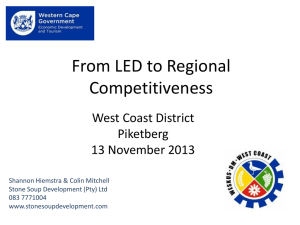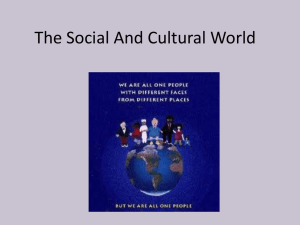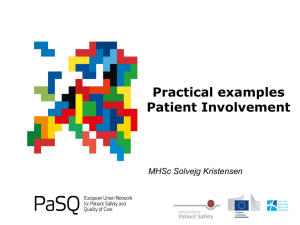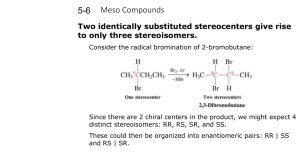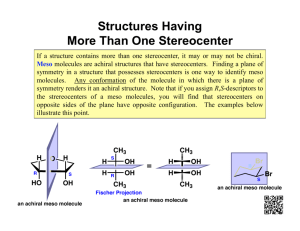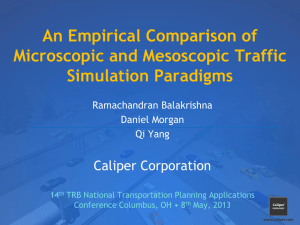Systemic Competitiveness
advertisement
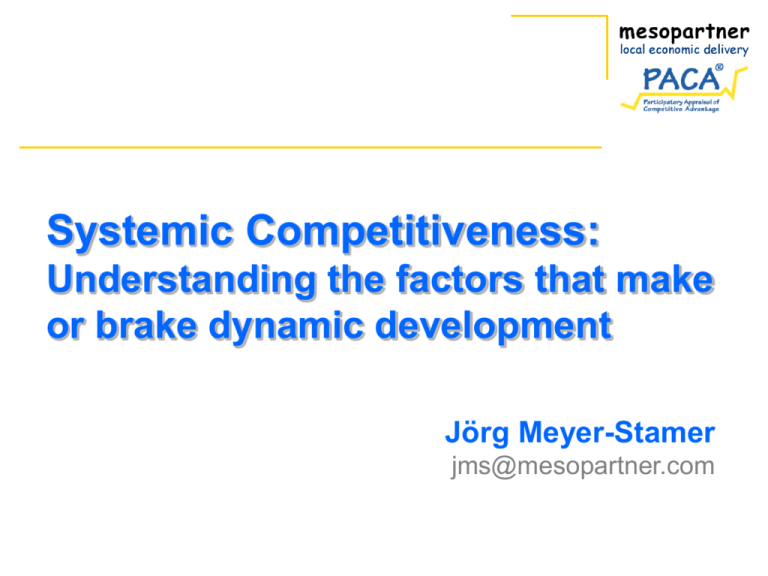
Systemic Competitiveness: Understanding the factors that make or brake dynamic development Jörg Meyer-Stamer jms@mesopartner.com What is “Competitiveness”? The ultimate measure of competitiveness is the ability of companies to thrive in competitive markets – so that they can pay attractive wages and thus contribute directly to wealth generation – so that they can pay taxes and thus enable government • to create a basis for corporate competitiveness (education, infrastructure, security, etc.) • to support those groups who are not / not yet / no longer capable of participating in a highly competitive, high performance environment What is Competitive Advantage? Comparative advantage (static advantage) Competitive advantage (dynamic advantage) Available of natural resources Created, high-value natural resources (e.g. FSC-certified plantations) Value-added attractions around a natural attraction (e.g. canyoning) Highly skilled and specialised labour Highly efficient, value-added infrastructure Tourism attractions like waterfalls Cheap labour Availability of real estate The orthodox view: Competitive companies as a result of an enabling environment Macroeconomy The sphere of economic framework conditions, creating the right incentives through laws, institutions (property rights etc.) and generic policies (exchange rate, monetary policy, open trade policy, etc.) Microeconomy Growth through entrepreneurship in functioning markets Why talk about “Systemic Competitiveness”? A stable macro-economic framework and an enabling environment are necessary but not sufficient conditions for competitiveness and growth Companies’ performance (micro-level) also depends on the availability of specialized factors and supporting institutions (meso-level) It is essential to understand a society’s capacity to create a favorable environment for economic development (meta-level) Dynamic development is not the result of isolated policies, but of the way numerous factors and policies interact inside a national or territorial system. The four levels of systemic competitiveness Meta level The sphere of societal framework conditions that guide decisions about fundamental economic alternatives Macro level The sphere of economic framework conditions, defining incentives through laws, institutions and generic policies Meso level The sphere of targeted interventions to address temporary and persistent market failure Micro level The sphere of allocation through markets, hierarchies & networks Terminological confusion Spatial development terminology Macro = national Micro = local Meso = somewhere in between often used in places without an intuitive understanding of “local” and “regional” Blakely and Bradshaw 2002, xvi (standard US textbook on LED): The terms “local” and “regional” are used interchangeably Systemic Competitiveness terminology Macro = generic framework conditions that apply to all sectors / industries alike Meso = targeted interventions, specialised organisations Policies, factors and elements between Macroeconomics and Microeconomics Micro = the world of microeconomics, i.e. companies and markets Meta / Macro / Meso / Micro have no spatial connotation Determinants of systemic competitiveness Meta level development-oriented patterns of political and economic organization value systems capacity to which encourage competitive economic formulate visions learning and change system and strategies social status of entrepreneurs stable, competition-oriented macro-economic, political and legal framework conditions exchange-rate policy monetary policy budgetary policy, fiscal policy collective memory Macro level Meso level regional policy infrastructure locational policy/ economic promotion anti-trust-policy targeted policies to strengthen the competitiveness of industries export promotion social cohesion, social capital trade policy industrial policy Micro level intra-firm effort to improve efficiency, quality, flexibility, responsiveness; business strategy environmental policy consumer protection formal and education informal copolicy operation, networks, alliances, collective technology policy learning Meso space: Institutions and orientations technology: contract research, information and technology transfer, consultancy, MSTQ -- business associations, universities and polytechnics specialization, selectivity, networking suppliers customers competitors education, training: public and private institutions quick adjustment to changing conditions financing: investment credit, working capital, collateral, venture capital, insurance SMEpatience and risk-friendly disposition support Firm Economic infrastructure: communication, promotion logistics, energy, water, waste disposal speed and efficiency exports: market information, design, packaging, export credit and insurance, trading firms specialization and close contact with firms and markets environmental protection: supervision, technology and management advice control / pressure and support Meso level, meso policy and meso space Meso level Analytical level Meso policy Targeted action of public and private actors – to address market failure – to strengthen the supporting environment for business – to shape structural change Selective interventions (as opposed to macro policy = generic interventions) Meso space Public and private organizations which are tasked with strengthening the competitiveness of businesses Meso level, policy, space: Justification Political justification: assure legitimacy – often creates perverse effects: interventions not guided by reason but by desparation, symbolic intervention, little performance pressure Economic justification: market failure – crucial distinction: temporary vs permanent meso policy transaction cost – but: government-created generic and meso-level transaction cost undermines the legitimacy of meso policy Temporary vs permanent mesopolicy Some meso-level interventions are permanent – because in some segments the market rarely works, e.g. due to strong externalities (training, R+D) Other meso-level interventions are permanent because they are clumsily designed Most meso-level interventions ought to be fixed-term – directly address the market failure – design an exit strategy at the outset – if necessary, empower business sector to take over initiative Systemic competitiveness: not only at the national level Meta Macro Supranational National Regional Local Competition between different models of market economy National integration Strategic capacity of national actors Regional identity Strategic capacity of regional actors Local identity, trust Strategic capacity Creative milieu Solid budgetary policy Government’s investment capacity Solid budgetary policy Government’s investment capacity Efficient regulation International capital Stable macro policy markets (opportunity + Liberal trade policy performance pressure) Anti-trust policy International trade Stable property rights Meso EU industrial policy EU technology policy Montréal protocol Technology policy Regional policy Export promotion Development finance Micro Transnationals, international alliances Global value chains Medium + large firms Disperse networks Supply chains Regional economic Local economic and promotion employment promotion Technology extension Competent chambers Education + training Real estate developm. SME Clusters Supply chains Clusters Industrial districts Supplier relationships Levels of Systemic Competitiveness and Levels of Policy-Making: The Case of Joinville (Brazil) Supranational National Meta culture of globalization strategic capacity of actors Macro international capital market Meso Montréal protocol Micro global textiles commodity chain Regional Local developmental commitment of state government macroeconomic budget policy of framework state government strategic capacity of actors national support institutions (training, finance) domestic suppliers, Multibrás supporting institutions in state capital supporting institutions inter-firm network in textile industry firms, networks, supplier relation-ships budget policy of city government Towards Systemic Competitiveness: Sequences in Santa Catarina Changes in the local business culture Meta Macro Fundamental changes in frameworkconditions (national level) Meso Micro Incremental adjustment within firms Restructuring of business associations Foundation / restructuring of support institutions Radical change within firms Restructuring of inter-firm relations Territorial development in the view of systemic competitiveness understand the logic of non-cooperation Meta-level identify the existence of social capital identify and remedy unfavorable macro-economic Macro-level conditions which retard local growth, create a local enabling environment (cut red tape etc.) restructure and re-orient existing institutions Meso-level create new support institutions address market failure Micro-level attract complementary firms initiate co-operation initiatives – which address immediate necessities – which give little opportunity for opportunistic behavior – which contribute to creating social capital Predictable outcome of a diagnostic based on the Systemic Competitiveness concept Strength Meta Macro Meso Micro Weakness * Market economy * Mutual mistrust + disarticula* Development orientation tion between public and * Willingness to engage in private sector collective effort to create * Mistrust between firms a competitive advantage * Mistrust between SME and LE * Low to moderate inflation * Complex, unfair tax system * Open trade regime * Government deficit * Existence of various institu- * Lack of customer focus tions: training, higher edu* Weak meso-micro link cation, SME support, finance * Weak business assns. * Competitiveness of * Survival economy leading firms * Weakness of MSME: capital, * Entrepreneurial spirit management, HR, technology This kind of result is boring and not very helpful! Operationalizing Systemic Competitiveness for field research Meta level Meta level factors Macro level * entrepreneurial spirit * co-operative spirit * capacity of articulation Macroeconomic conditions Government Meso level Training Technology Financing Business Assns. etc. Relations with meso-institutions Micro level Relations with Factors inside the firm suppliers + subcontractors Relations with customers Relations with competitors Using the Systemic Competitiveness concept: Leading questions How do factors at different analytical levels influence each other? – Are there vicious circles? – Are there virtuous circles? What is the capacity of actors / stakeholders – to implement specific activities which you consider useful? – to collaborate with other actors? Where are the points of leverage to weaken vicious circles and strengthen virtuous circles? A township economy vicious circle Small businesses don’t grow Small businesses want to stay small = invisible, not getting robbed Crime Few jobs created Low income An industrial cluster virtuous circle High density of specialised businesses Easy availability of suppliers and customers Easily visible business opportunities Low barriers to entry for new businesses PACA effects: A Systemic Competitiveness perspective Meta Macro Closer interaction between public and private sector More efficient public service, less red tape Meso Supporting institutions Micro Networking between companies, collective action Chambers, business associations Matching Business development services Challenges for systemic competitiveness Develop a realistic perspective at the latitude for government action Develop a realistic perspective at the latitude for action of local stakeholders Relieving government and stakeholders of nonpriority tasks, create functioning markets (BDS, M4P) Prepare the public sector to take over a new role: facilitate and moderate instead of intervening and distorting Empower the private sector to take care of its problems = organizational development in business associations Thank you for your attention!
